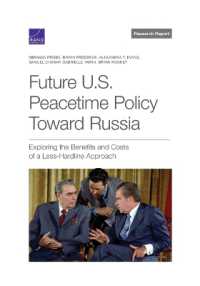- ホーム
- > 洋書
- > 英文書
- > Politics / International Relations
Full Description
The challenge of teaching international studies is to help you think coherently about the multiple causes and effects of global problems. In International Studies: Global Forces, Interactions, and Tensions, award-winning scholars Scott Straus and Barry Driscoll give you a clear framework that pinpoints how key factors-forces, interactions, and tensions-contribute to world events, with both global and local consequences.The authors first show you how to look for common patterns in global issues by introducing four world-shaping forces: global markets, shifting centers of power, information and communications technologies, and global governance. They systematically trace how these forces prompt interactions among world actors and thus give rise to a set of tensions that spur key challenges. The framework enables you to ask and answer for yourself-Who is interacting? Where did such interactions develop? What policies or institutions govern them? Why are they getting certain global and local reactions? You are then apply the framework to the global problems that matter most to you: human rights abuses, economic inequality, terrorism, forced migration, pandemics and global health responses, climate change, food security, and more. International Studies raises the bar for the Introduction to IS course, moving beyond interdisciplinary, and into the realm of critical analysis to increase student relevancy and motivation.
Contents
PrefaceAbout the AuthorsAcknowledgmentsINTRODUCTION: Global Interactions and Global TensionsA Framework for International StudiesGlobal InteractionsGlobal TensionsAn Inside-Out/Outside-In ApproachGlobal ForcesWhat Is International Studies Good For?Key TermsQuestions for ReviewLearn MorePART I: FOUNDATIONSCHAPTER ONE: The Making of Our Global Age: Forces, Interactions, and Tensions Since 1800The First Global Age: Increasing Global InteractionsBetween the First and Second Global Ages: Wars, Hot and Cold, and New InteractionsThe Second Global Age: An Explosion of Global Finance, International Interactions, and New TensionsSummaryKey TermsQuestions for ReviewLearn MoreCHAPTER TWO: States: Shapers and Subjects of Global InteractionsThe Age of States: Born from a Cycle of InteractionsWhat Does a State Do?Where Do States Come From? Forces Shaping the Modern StateThe Strengths and Weaknesses of StatesIs the State Fit for Purpose? Modern Challenges to StatesSummaryKey TermsQuestions for ReviewLearn MoreCHAPTER THREE: Intergovernmental Organizations: Sites of Global GovernanceGetting Along in the WorldIGOs: The BasicsWhat Do IGOs Do?The United Nations: Mediating Global TensionsDo IGOs Actually Matter? Three ViewsSummaryKey TermsQuestions for ReviewLearn MoreCHAPTER FOUR: Civil Society: Agents of Change in Global InteractionsWho Cares About Cecil the Lion?What Is Civil Society?Who Is Civil Society?Recent History of Global Civil Society: Rise of a New Global ForceCivil Society on the Global StageHow Does Civil Society Have an Impact?Criticisms of Global Civil SocietySummaryKey TermsQuestions for ReviewLearn MoreCHAPTER FIVE: Social Identities and Culture: Shaping Interactions at the Individual and Societal LevelsWhat Are Social Identities and Culture?Global Interactions and Forces Impact Identity and CultureWhich Social Identities Matter?Why Do Some Social Identities Matter More Than Others?Social Identities and Global ChallengesUnderstanding CultureSummaryKey TermsQuestions for ReviewLearn MoreCHAPTER SIX: Money: Propelling Global InteractionsWhy Global Money MattersWhat is Capitalism?What is Trade?Finance: Borrowers, Lenders, and Debt Currencies FloatingSummary Key TermsQuestions for ReviewLearn MorePART II: GLOBAL CHALLENGESCHAPTER SEVEN: Democracy and Representation: Struggles for Freedom and Efforts to Restrict ItWhat Makes Some Countries Freer Than Others?What Do Democracies Consist Of?What Do Dictatorships Consist Of?Trends in DemocratizationThe Process of DemocratizationDemocratic ConsolidationDemocracy and International Studies ThemesSummaryKey TermsQuestions for ReviewLearn MoreCHAPTER EIGHT: Human Rights: The Challenge of Setting and Enforcing Global NormsWhat is the Human Rights Regime?Human Rights at the UN Level: Roots of the Tension Between Universal Rights and State Sovereignty Regional Approaches to Human RightsWhat Roles Do Nonstate Human Rights Actors Play?Do Human Rights Work?SummaryKey TermsQuestions for ReviewLearn MoreCHAPTER NINE: Development: The Challenge of Global PovertyWhat Is Development, and How Is It Measured?Why Are Some Countries Poor?How Can Developing Countries Grow Their Economies? Five TheoriesThe Role of Foreign AidSummaryKey TermsQuestions for ReviewLearn MoreCHAPTER TEN: Civil Wars and Terrorism: New Global Security Challenges and Efforts to Manage ThemWhat Are Civil Wars?What Is Terrorism?SummaryKey TermsQuestions for ReviewLearn MoreCHAPTER ELEVEN: Migration: Confronting the Myths of Human MovementWhat is Migration?Trends in Global Migration: Facts and MythsWhy Do People Migrate? Push, Pull, and Policy FactorsThe Impacts of MigrationBrain Drain or Brain Gain?Human Trafficking and Modern SlaveryCan Migration Be Governed Globally?SummaryKey TermsQuestions for ReviewLearn MoreCHAPTER TWELVE: Global Health: Addressing Inequalities in OutcomesGlobal Health and Forces, Interactions, and TensionsWhat is Global Health?Global Health Outcomes Highlight Systemic InequalitiesThe Global HIV and AIDS PandemicSummaryKey TermsQuestions for ReviewLearn MoreCHAPTER THIRTEEN: Global Environment: Confronting the Challenge of Climate ChangeWhat Is Climate Change?Empirics of Climate ChangePredictions about Future Climate ChangeImpacts of Climate ChangeResponses to Climate Change: Global GovernanceOther Approaches to Climate ChangeClimate Change and Cross-Cutting Global ForcesSummaryKey TermsQuestions for ReviewLearn MoreCHAPTER FOURTEEN: Global Food: How Can We Solve World Hunger?Global Hunger and a Growing Population: Is There Enough Food?If There Is Enough Food, Why Do Famines Occur?Reducing Hunger: Food Security or Food SovereigntyWho Runs Global Food?Tracing Global Food: Commodity ChainsSummaryKey TermsQuestions for ReviewLearn MoreGlossaryIndex







